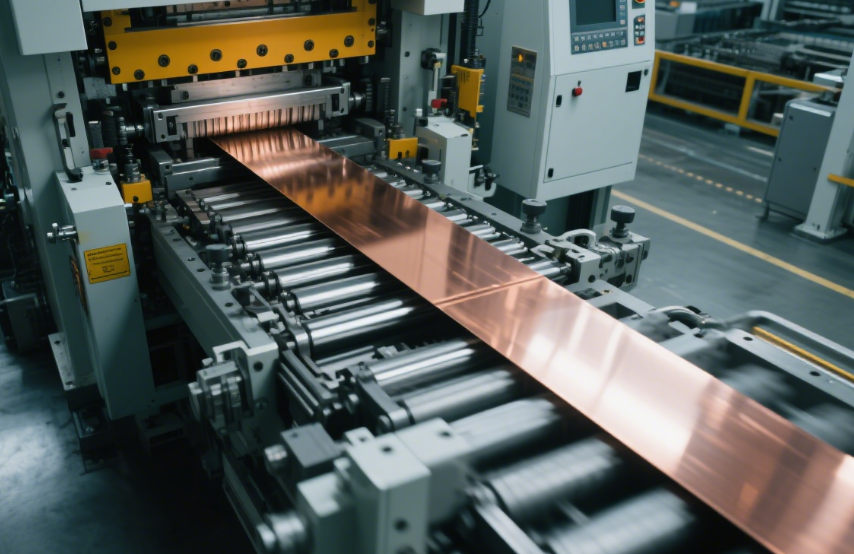What are you looking for?
At Essai Group, we work with some of the most innovative companies in the world, and a common thread among them is the need for components that deliver uncompromising performance. When it comes to electrical and thermal conductivity, few materials can match the efficiency of copper. But turning raw copper into a complex, high-performance component requires more than just a great material—it requires a mastery of the stamping process.
While some might think of stamping as a simple act of pressing metal, the reality of industrial precision stamping is a sophisticated blend of engineering, metallurgy, and advanced technology. In this post, we'll walk you through why copper is such a critical material and how our industrial stamping process ensures your components meet the most demanding specifications.
The unique properties of copper make it an indispensable material in modern manufacturing. It's not just one feature, but the combination of several powerful attributes that makes it the go-to choice for so many critical applications. In our experience, clients choose copper primarily for these four reasons:
Exceptional Electrical & Thermal Conductivity: Copper is the standard-bearer for conductivity. This makes it essential for any part that needs to efficiently transmit electrical currents or dissipate heat, from tiny electronic connectors to robust automotive busbars.
Excellent Malleability: Copper is highly ductile and malleable, meaning it can be bent, stretched, and formed into complex geometries without fracturing. This is a massive advantage in progressive die stamping, allowing us to create intricate parts with tight tolerances in a single, high-speed process.
Inherent Corrosion Resistance: Copper naturally resists oxidation and corrosion. This ensures long-term reliability and performance, which is especially critical for components used in harsh environments or products with long service lives.
Strength and Durability: While malleable, copper alloys can be formulated to provide significant strength and fatigue resistance. We frequently work with materials like Beryllium Copper (BeCu) for parts that need to maintain their shape and function under mechanical stress, such as spring contacts and terminals.
Hand stamping is an art form; industrial stamping is a science. Our process is designed for precision, repeatability, and efficiency, capable of producing millions of identical parts with tolerances measured in microns. The journey from a digital file to a physical component involves several meticulous steps:
Design & Engineering Consultation: It starts with your design. Our engineering team collaborates with yours to ensure the part is optimized for manufacturability (DFM), suggesting minor adjustments that can improve performance and reduce cost.
Precision Tool & Die Creation: This is where our expertise truly shines. Using advanced CAD/CAM software and CNC machining, we design and build the progressive dies that will form your part. The precision of this tool determines the precision of the final component.
Material Selection & Preparation: We source the exact copper alloy specified for your project, whether it's C110, C102, or a specialized performance alloy. The material is prepared and fed into our stamping presses.
High-Speed Progressive Stamping: The copper strip is fed through the progressive die. With each stroke of the press, the die performs a series of operations—punching, coining, bending, and forming—to gradually shape the part. This all happens at incredibly high speeds, allowing for cost-effective mass production.

Where does all this technology end up? You'll find our precision stamped copper components in some of the most advanced products on the market. The copper stamping applications are vast, but they are most critical in industries where performance cannot be compromised.
Electronics & Telecommunications: For connectors, terminals, lead frames, and RF shields, copper's conductivity is essential for clear signals and reliable power delivery.
Automotive: In both traditional and electric vehicles, stamped copper is used for battery terminals, busbars, sensor components, and power distribution systems.
Medical Devices: The reliability and biocompatibility of certain copper alloys make them suitable for internal connectors and components in diagnostic equipment.
Renewable Energy: Copper parts are crucial for efficiently collecting and transferring energy in solar panels, inverters, and wind turbine systems.
| Step | Process Stage | Description | Result |
|---|---|---|---|
| 1 | Client CAD File | The process begins with your digital design file, which specifies the component's geometry and dimensions. | Initial Design Input |
| 2 | DFM Review | Our engineers analyze the design for manufacturability, identifying potential optimizations for cost and performance. | A Validated, Production-Ready Design |
| 3 | Tool & Die Manufacturing | We fabricate a high-precision progressive die—the custom tool that will shape the copper. | A High-Precision Stamping Tool |
| 4 | High-Speed Stamping | A copper coil is fed through the press, where the die stamps the parts at high speed. | Mass-Produced Raw Components |
| 5 | Quality Control | Each part is inspected using vision systems and metrology tools to ensure it meets all specifications. | Quality-Assured Components |
| 6 | Finished Part | Components are finished (if required), packaged, and delivered, ready for integration into your assembly. | A Ready-to-Integrate Final Part |
Our role as a manufacturing partner doesn't have to end when the part comes off the press. A finished component often requires secondary processes to achieve its final specifications. Our Essai manufacturing provides a full suite of in-house services to deliver a complete, ready-to-integrate solution. This includes:
Plating: Applying coatings like tin, nickel, or silver to enhance corrosion resistance or solderability.
Heat Treating: To optimize the hardness and mechanical properties of the copper alloy.
Tapping & Assembly: Creating threaded features or assembling stamped parts with other components.
By managing these processes under one roof, we ensure consistent quality and simplify your supply chain. If your next project demands the unparalleled performance of copper and the precision of industrial stamping, our team is ready to help. We combine decades of experience with cutting-edge technology to turn your complex designs into reality.